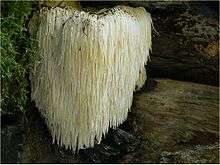Hericium erinaceus
| Hericium erinaceus | |
|---|---|
 | |
| Scientific classification | |
| Kingdom: | Fungi |
| Division: | Basidiomycota |
| Class: | Agaricomycetes |
| Order: | Russulales |
| Family: | Hericiaceae |
| Genus: | Hericium |
| Species: | H. erinaceus |
| Binomial name | |
| Hericium erinaceus (Bull.) Persoon | |
| Synonyms | |
| |
| Hericium erinaceus | |
|---|---|
|
| |
| teeth on hymenium | |
| no distinct cap | |
| lacks a stipe | |
| spore print is white | |
| ecology is parasitic | |
| edibility: choice | |
Hericium erinaceus (also called lion's mane mushroom, bearded tooth mushroom, satyr's beard, bearded hedgehog mushroom, pom pom mushroom, or bearded tooth fungus) is an edible and medicinal mushroom belonging to the tooth fungus group. Native to North America, Europe and Asia it can be identified by its long spines (greater than 1 cm length), its appearance on hardwoods and its tendency to grow a single clump of dangling spines.[1] Hericium erinaceus can be mistaken for other species of Hericium, all popular edibles, which grow across the same range. In the wild, these mushrooms are common during late summer and fall on hardwoods, particularly American beech.
Chemistry
Hericium erinaceus contains a number of polysaccharides, such as B-glucan, heteroglucans, heteroxylans, as several cyanthane derivative triterpenes known as hericenone and erinacine.[1]
Culinary use
Hericium erinaceus is a choice edible when young, and the texture of the cooked mushroom is often compared to seafood. It often appears in Chinese vegetarian cuisine to replace pork or lamb. This mushroom is cultivated commercially on logs or sterilized sawdust and is available fresh or dried in Asian grocery stores.
Alternative names
It is called hóu tóu gū (simplified: 猴头菇; traditional: 猴頭菇; lit. "monkey head mushroom") in Chinese. In Japanese it is called yamabushitake (山伏茸; lit. "mountain priest mushroom"). In Vietnamese it is called nấm đầu khỉ which literally means the same as hóu tóu gū (monkey head mushroom). In Korean it is called "노루궁뎅이버섯, "norugongdengi-beoseot", literally "deertail mushroom".
Research and use
Hericium erinaceus has long a history of use in traditional Chinese medicine.[2] Long-term safety and effects of withdrawal are unknown.
Gallery
See also
References
- 1 2 Friedman, Mendel (2015). "Chemistry, Nutrition, and Health-Promoting Properties of Hericium erinaceus (Lion's Mane) Mushroom Fruiting Bodies and Mycelia and Their Bioactive Compounds". J. Agric. Food Chem. 63: 7108–7123. PMID 26244378. doi:10.1021/acs.jafc.5b02914.
- ↑ Jiang, Shengjuan; Songhua Wang; Yujun Sun & Qiang Zhang (September 2014). "Medicinal Properties of Hericium Erinaceus and Its Potential to Formulate Novel Mushroom-based Pharmaceuticals". Applied Microbiology and Biotechnology. 98 (18): 7661–7670. PMID 25070597. doi:10.1007/s00253-014-5955-5.
External links
| Wikimedia Commons has media related to Hericium erinaceus. |
- Hericium erinaceus (bearded tooth) - Kew Gardens
- Hericium erinaceus at mushroomexpert.com
- Hericium erinaceus - photos

